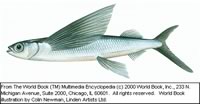|
The Project
 Research Methods Research Methods
 Research Questions Research Questions
The Locations
How to Use This Site
Links
Part 1:
January 25 - February 9, 2005
The Team
Daily Journal
New Horizon Daily Report
New Horizon Cruise Track
Part 2:
July 23 - August 13, 2005
The Team
Daily Journal
New Horizon Daily Report
New Horizon Cruise Track
Part 3:
August 30 - September 8, 2005
The Team
Daily Journal
R/V Wecoma Daily Report
R/V Wecoma Cruise Track
Contact Us

|
Daily Journal |
Part 2
July 23 - August 13, 2005
|
11 August, 2005
More from The Log from the Sea of Cortez
The Western Flyer hunched into the great waves towards Cedros Island, the wind blew off the tops of the whitecaps, and the big guy wire, from bow to mast, took up its vibration like the low pipe on a tremendous organ. It sang its deep note into the wind.
We, too, are cruising past Cedros Island on the north coast of Baja, about 30 hours away from San Diego. The captain said we are in a little-known current, the Davidson Current, which runs north, as opposed to the California Current, which runs south towards the Equator. The seas are very calm and have taken on that familiar gray color as we make good time running with the current on our way home. The flying fish are still with us, and seals have been spotted among the kelp beds. Just before lunch a pair of whales, maybe humpbacks, appeared close off the starboard side of the ship. After dinner, we saw the water spouts of more whales.
The Flying Fish

The scientists are packing up all their equipment to be sent back to their labs at the University of Hawaii in Honolulu and Oregon State University in Corvallis. Next week the R/V New Horizon will leave San Diego and go to Monterey Bay in California. There will be another adult education teacher onboard, so you can read her journals on the same website.
The R/V New Horizon is part of the fleet that the Scripps Institute of Oceanography maintains to do oceanographic research. It is part of the University of California, San Diego. Scripps began as a marine laboratory in the early 20th century. Today Scripps trains graduate students and conducts research in marine, atmospheric, and space sciences. All of these disciplines fall under the study of earth sciences. Last year, Scripps received $300,000,000 from federal, private and international grant resources. Scripps and Woods Hole in Massachusetts are the leading oceanographic research facilities in the world.
Math Problem:
The ABs are in a constant battle with the forces of rust and corrosion aboard the R/V New Horizon. An AB can chip a section of metal 3 feet by 3 feet every hour. If an AB begins chipping rust at 9 am and works until 3 pm, with a 15 minute break every hour, how much of an area can he or she chip?
Trivia Tidbit of the Day:
When Thor Heyerdahl and five companions sailed a balsa wood raft, the Kon Tiki, from Peru to islands in eastern Polynesia in 1947, they left a crate tipped on its side on the back of the raft. When they woke up in the morning, it was full of flying fish that had mistakenly flown onboard. The crew enjoyed them for breakfast.

|







